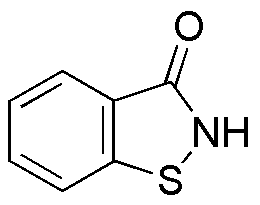1,2-Benzisothiazol-3(2H)-one is widely utilized in research focused on:
- Biocide Applications: This compound is effective as a biocide, used in various formulations to prevent microbial growth in industrial settings, such as water treatment and paint preservation.
- Cosmetic Preservation: It serves as a preservative in cosmetic products, helping to extend shelf life by inhibiting the growth of bacteria and fungi, ensuring safety for consumers.
- Polymer Stabilization: In the plastics industry, it is used as an additive to enhance the stability and durability of polymers, providing resistance against degradation from environmental factors.
- Analytical Chemistry: The compound is utilized in analytical methods to detect and quantify various substances, making it valuable for quality control in pharmaceuticals and food industries.
- Research in Material Science: It plays a role in developing new materials with specific properties, such as improved thermal stability and resistance to oxidation, which are crucial for advanced applications.
General Information
Properties
Safety and Regulations
Applications
1,2-Benzisothiazol-3(2H)-one is widely utilized in research focused on:
- Biocide Applications: This compound is effective as a biocide, used in various formulations to prevent microbial growth in industrial settings, such as water treatment and paint preservation.
- Cosmetic Preservation: It serves as a preservative in cosmetic products, helping to extend shelf life by inhibiting the growth of bacteria and fungi, ensuring safety for consumers.
- Polymer Stabilization: In the plastics industry, it is used as an additive to enhance the stability and durability of polymers, providing resistance against degradation from environmental factors.
- Analytical Chemistry: The compound is utilized in analytical methods to detect and quantify various substances, making it valuable for quality control in pharmaceuticals and food industries.
- Research in Material Science: It plays a role in developing new materials with specific properties, such as improved thermal stability and resistance to oxidation, which are crucial for advanced applications.
Documents
Safety Data Sheets (SDS)
The SDS provides comprehensive safety information on handling, storage, and disposal of the product.
Product Specification (PS)
The PS provides a comprehensive breakdown of the product’s properties, including chemical composition, physical state, purity, and storage requirements. It also details acceptable quality ranges and the product's intended applications.
Certificates of Analysis (COA)
Search for Certificates of Analysis (COA) by entering the products Lot Number. Lot and Batch Numbers can be found on a product’s label following the words ‘Lot’ or ‘Batch’.
*Catalog Number
*Lot Number
Certificates Of Origin (COO)
This COO confirms the country where the product was manufactured, and also details the materials and components used in it and whether it is derived from natural, synthetic, or other specific sources. This certificate may be required for customs, trade, and regulatory compliance.
*Catalog Number
*Lot Number
Safety Data Sheets (SDS)
The SDS provides comprehensive safety information on handling, storage, and disposal of the product.
DownloadProduct Specification (PS)
The PS provides a comprehensive breakdown of the product’s properties, including chemical composition, physical state, purity, and storage requirements. It also details acceptable quality ranges and the product's intended applications.
DownloadCertificates of Analysis (COA)
Search for Certificates of Analysis (COA) by entering the products Lot Number. Lot and Batch Numbers can be found on a product’s label following the words ‘Lot’ or ‘Batch’.
*Catalog Number
*Lot Number
Certificates Of Origin (COO)
This COO confirms the country where the product was manufactured, and also details the materials and components used in it and whether it is derived from natural, synthetic, or other specific sources. This certificate may be required for customs, trade, and regulatory compliance.


